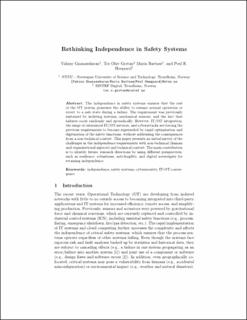| dc.description.abstract | The independence in safety systems ensures that the rest of the OT system possesses the ability to resume normal operation or revert to a safe state during a failure. The requirement was previously sustained by isolating systems, mechanical sensors, and the fact that failures occur randomly and sporadically. However, IT/OT integration, the surge of outsourced IT/OT services, and cyberattacks are forcing the previous requirements to become superseded by rapid optimization and digitization of the safety functions, without addressing the consequences from a non-technical context. This paper presents an initial survey of the challenges in the independence requirements with non-technical (human and organizational aspects) and technical context. The main contribution is to identify future, research directions by using different perspectives, such as resilience, robustness, anti-fragility, and digital sovereignty for retaining independence. | en_US |
